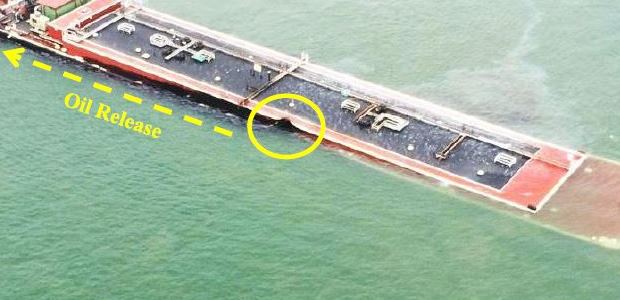
NTSB Opens Accident Docket on 2014 Houston Ship Channel Collision
The March 22, 2014, collision caused an oil spill that closed the channel for three days, coated 13 miles of shoreline heavily with oil, and affected about 40 miles with light to moderate amounts of oil, according to the Environmental Response Investigative Group chairman's report.
The National Transportation Safety Board has opened its accident docket on the March 22, 2014, collision of a cargo ship and a tank barge in the Houston Ship Channel. The docket's more than 4,000 pages include a summary of the accident, transcripts from interviews with crew members from both vessels and witnesses aboard nearby vessels, and investigative group chairman factual reports. The Environmental Response Investigative Group chairman's report by Paul L. Stancil, an NTSB senior hazmat accident investigator, discusses how the collision occurred and how agencies responded to the spill, which closed the busy channel for three days, caused about 13 miles of shoreline to be heavily oiled, and about 40 miles to be affected with light to moderate amounts of oil, according to this report.
The cargo ship Summer Wind was traveling inbound when it collided with an outbound two-barge tow being pushed by the tow boat Miss Susan in the connecting waterways of the Bolivar Roads Precautionary Area where the Galveston Channel, the Texas City Channel, and the Gulf Intracoastal Waterway intersect with the Houston Ship Channel, it states: "Both vessels, the Summer Wind (pilot) and the Miss Susan (captain) had stated their intentions several times via radio broadcasts. The pilot radioed on VHF channel 13 the vessel was leaving anchorage heading for Houston some 20 minutes before the accident. The captain on the Miss Susan radioed her intention to proceed out of the Texas City channel bound for Bolivar about 15 minutes prior to the accident. Although the fog had cleared to about a mile of visibility north and south of the accident area, there was a thicker area of patchy fog lingering around the intersection of the ICW and HSC. The pilot was using a portable pilot unit (PPU) laptop and both vessels had working radars and automatic identification system (AIS), but neither vessel contacted each other by radio until 3 minutes before the accident. The two vessels were in a close quarters situation in restricted visibility with the eastbound Miss Susan trying to cross the HSC in front of the northbound Summer Wind. Just prior to and upon sighting each other (with less than 800’ of visibility) both vessels tried evasive maneuvering to no avail. The bulbous bow of the Summer Wind struck the lead barge 27706 on the starboard side just forward of midships, puncturing a hole through the double hull of cargo tank #2 starboard containing 4,159 barrels and releasing approximately 4,000 barrels (168,000 gallons) of cargo fuel oil into the waterway. Two crew members of the Miss Susan suffered injuries from exposure to the hydrocarbon vapor."
This report says investigators retrieved and reviewed the voyage data recorder from the Summer Wind along with data from the Sector's Vessel Traffic Service (VTS) at Sector Houston-Galveston's Command Center in Ellington Field Houston, Texas. Investigators interviewed crew members from both vessels and other vessels that witnessed the accident, but the captain of the Miss Susan was not interviewed until a Coast Guard hearing took place June 2-5, 2014. In addition, the Houston pilot aboard the Summer Wind "refused to turn over his PPU to the Coast Guard until ordered by a judge nine months after the accident," the report states.
The NTSB sent four investigators to the scene of the collision.
The report cites a 2009 waterway safety assessment of the Port of Houston-Galveston by the Coast Guard's Office of Waterways Management that reported the economic impact of closing the Houston Ship Channel was about $13.3 million per hour, or $330 million to $400 million per day.